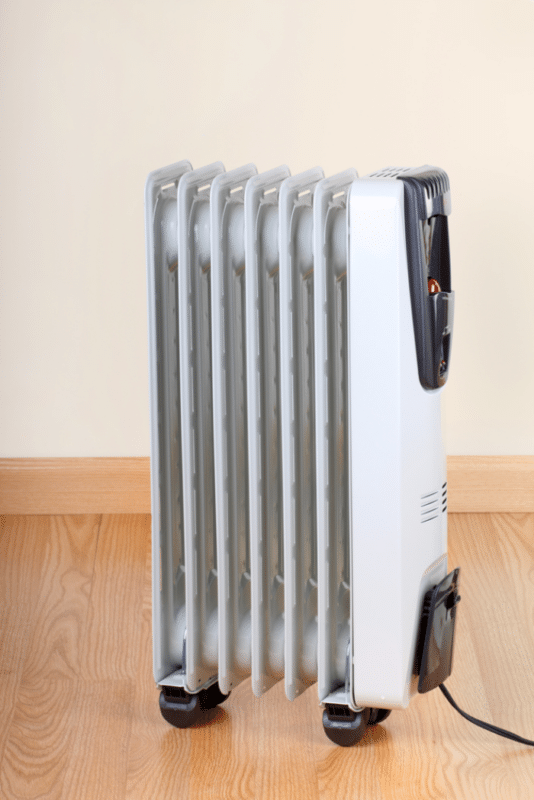We've independently reviewed this article to make sure it's as accurate as we can make it.
To find out more about our article creation and review process, check out our editorial guidelines.
If you live in the north, I bet you’ve asked the question how much does it cost to heat a garage a time or ten. Especially if you have an attached garage.
And you don’t even need to be in the far north to wonder about the answer to that.
Ultimately, how much it costs will depend on your heating method and the cost of fuel in your area, but I’ll start off with an example and then expand on it from there.
A 45,000 BTU forced air heater is typically large enough for a large two-car garage, but this can depend on variables like climate, ceiling height, and insulation. Assuming you’re using electricity, and your price per kWh is 10¢, running your heater for 4 hours will cost about $5.25.
Want something more precise? Use our custom calculators to determine your own costs, depending on how you’re heating the garage:
Underfloor Heating Costs Calculator
Garage Insulation Costs Calculator
Keep reading, and I’ll get into all the nitty-gritty about heating a garage.
The Importance of Insulation
Did you catch what I said above about the amount of energy you need to heat a space can depend on how well it’s insulated?

If you plan to heat or air condition any space, your most important first step is insulation.
You’re here in the first place because you have some degree of angst about the cost of heating. Skipping insulation pretty much equates to burning money, and I know you aren’t that person!
Insulation does its job by controlling heat flow. Heat in or heat out of a space. Since you’re looking at heaters, your goal is to keep heat in. Your insulation acts as a barrier, stopping all that heat you’re creating—and paying for—from escaping.
In the summer, it will do the exact opposite and keep the heat out.
So the better insulated your garage the better your energy savings. The more money you’ll have to spend on other things. Like the things you keep in your garage!
Check out this guide to help choose the most cost effective insulation for your garage.
Different Types of Garage Heaters
When it comes the heating your garage, there isn’t a one size fits all choice. There are different factors that might make one type better than another. For example, do you simply park your car in this space or does it double as a workshop of sorts?
Some options are as simple as plug and go while others will be more complex—especially when it comes to installation.
Space Heaters
Within this category, there’s a lot of choices. Probably because the term is used quite loosely.
By definition, a space heater is any heater that’s used to heat a single area, such as a room or part of a room. In contrast to central heating, which is used to heat connected spaces.

So to avoid any confusion here, I’m using the term space heater as defined above.
Infrared Heaters
The cheapest type of space heater to run is an infrared heater. Since they’re also relatively inexpensive to buy, if you’re main interest—next to heat—is cost, these heaters are a great choice.
An infrared heater uses less wattage compared to other heaters. Typically, 7 watts per square foot as opposed to 10 watts. This equates to an energy savings of about 30 to 40% by comparison.
Infrared heaters work differently, in that they heat up objects instead of the air surrounding an object. This would include you if you use your garage as a workshop, or your car if you simply use the garage to park.
However, there are some downsides.
Cons:
- Depending on the type you’re looking at, some infrared heaters can be costly.
- They only heat what’s directly in their path.
- Ceiling mounts need to be at least 7 feet off the floor and 4 inches away from the ceiling.
- They often lack variable controls
Oil Filled Heaters
Not to be confused with an age-old radiator, today’s oil-filled heaters are both cost-effective and near-silent.
These convection heaters have much lower power consumption in comparison to electric heaters. The oil warms up, which in turn warms the surrounding metal—called fins—and then warms up the air.
When the oil reaches the desired temperature, the unit will shut off but the oil retains its heat for a period of time. This means you get longer-lasting heat at less the cost.
But again, there are some things they don’t have going for them.
Cons:
- It takes time for the oil to heat up, meaning it’s going to take a while for the area to heat up as well.
- They’re heavy and often difficult to move around.
- They’re not the best choice if you have a larger space you need to heat.
Storage Heaters
If your goal is to keep usage costs down, this is the heater for you. They’re called storage heaters because they store energy obtained at off-peak hours. This often means a savings of about 50%
However, these heaters do have a significant drawback.
Cons:
They are very expensive upfront, so you may want to do some calculations to see if the reduction in usage cost is enough to offset the initial cost.
So How Much Does It Cost to Run a Space Heater?
The calculation itself is a fairly simple one but determining your costs will depend on a variety of factors.
- The type of space heater (some different types are mentioned above)
- The type of power or fuel it uses
- How much of that power or fuel you use in order to run your heater
- How long you run it for
- Your local electricity, natural gas, or propane costs. Click here to find out the cost of electricity in your area.
Take all that into consideration, and it could cost you anywhere from $0.08 to $0.30 per hour and $1 to $4 per day to operate your heater.
Having said all that, if you already know all the variables, you can determine your ultimate costs.
Here’s a possible scenario. You have a 1500-watt electric space heater, and your local energy rates are 11¢ per kilowatt-hour. If you were to run your heater for 24 hours a day, which is unlikely and not recommended, it would cost you $3.78 to run.
Here is the calculation. 1,500 watts x 24 hours ÷ 1,000 x 11¢ = $3.78 per day.
The reason behind dividing your watts by 1,000 is to convert them into kilowatt-hours since that’s how electricity bills are invoiced.
Forced Air Garage Heaters
These systems are easy to install and operate much like the furnace in your home, making them a very popular choice for garage heaters.
They’re typically powered by electricity or natural gas, and they draw cold air from outside the garage, move it across a heating element, and then it blows warm air inside.
These heaters deliver instant heat, but they will take a little while to warm up your space entirely. The bonus is that unlike some other types of heaters, you can set a thermostat to the desired temperature, just like you do in your home.
Popular forced air heaters include features like:
- Permanent or portable heaters
- Easy electronic ignition
- Fuel shutoffs
- Adjustable thermostats
- Automatic overheat shutoffs
If you have natural gas piped to your home, getting a gas heater added to your line is the best—and cheapest idea. The operational costs of the electric version are more than the gas version.
These heaters are typically mounted in an upper corner of the garage, near the gas line and electrical outlet.
The guidelines for sizing are to purchase a 45,00O BTU unit for a garage that fits 2.5 cars and 60,000 BTUs for a three-car garage. Other variables will depend on your climate zone and your ideal heat settings.
Underfloor Heating
As I mentioned at the outset, we go from the simple, portable space heater to more complex options, so let’s move on to those.

Unless you’re dealing with a new build, this option means a renovation since this type of heater is mounted between the subfloor and flooring.
If you can think past the cost and disruption of installing in-floor radiant heating, it’s probably one of the most efficient types of heating there is.
Since there’s no ductwork, there’s no heat loss. And since heat radiates up through the floor, it’s much more evenly distributed than heat from baseboard radiators of forced air heaters.
The most popular types available are electric and hydronic underfloor heaters. Hydronic systems operate by running liquid through tubing in the floor to spread heat.
Electric Underfloor Heating
First, the cost. According to WarmlyYours, electric underfloor heating can cost from $5 per square foot for larger projects using cables and strips up to $30 for a custom option using mats.
Generally speaking, electric radiant floors are composed of either mats or cables of conductive plastic. They can be placed on top of the subfloor or embedded within the concrete. The second option is the most energy efficient and cost effective since the concrete will retain thermal mass—the heat.
Your flooring, assuming you use some sort of tile flooring system in the garage can’t hold heat. Added to that, if you do use a flooring system, make sure it’s made to use with radiant heating. Garage flooring systems are often made of vinyl or PVC.
The good news is that most garage floors are concrete, which means that if this is a new build, it’s just another step in a process already in place. However, if you are adding radiant flooring in an existing garage, the process is still fairly simple.
You’ll need to do a wet application, meaning you lay down your heating system and then pour a few inched of new concrete over the top of it.
Hydronic Underfloor Heating
According to HomeAdvisor, installing hydronic underfloor heating can cost between $6 and $20 per square foot, putting the average cost at about $13 per square foot.
There’s also an additional cost of the water heater. There are two options for the heater.
- Water heaters will cost between $770 and $1,450 to install
- Boilers will cost between $3,500 to $7,700 to install
So it will cost more to install hydronic underfloor heating than it will for electric heating. But there is an advantage.
The hot water in the tubes will retain their heat for a while. So the system doesn’t need to run as long as an electric system does.
Conclusion
There are a lot of options when it comes to heating your garage, and with that comes a variety in pricing. For example, underfloor heating could cost you anywhere from $5 to $30 per square foot, and you might need to add a water heater as well.
Ultimately, decide on your budget and factor in what you plan to do in your space. If you’re a hobbyist and have a shop in your garage instead of a car, something like forced air that will end up blowing dust around might not be the best idea.
Hopefully, you’ve found some answers and direction here, so thanks for reading. Why not check below to see if there’s anything else we can help you with?







